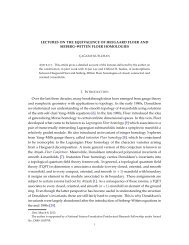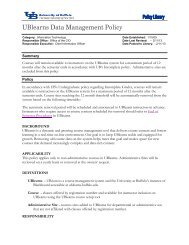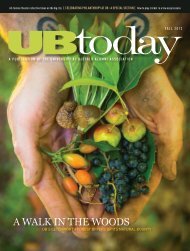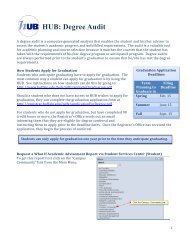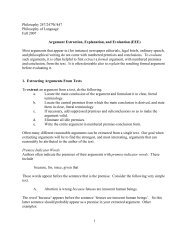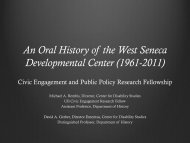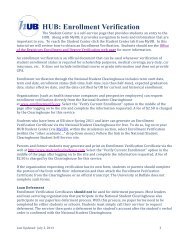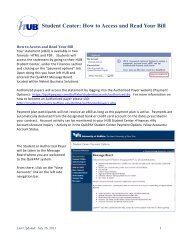Why children are getting and what UB is - University at Buffalo
Why children are getting and what UB is - University at Buffalo
Why children are getting and what UB is - University at Buffalo
You also want an ePaper? Increase the reach of your titles
YUMPU automatically turns print PDFs into web optimized ePapers that Google loves.
finalword<br />
Food for Thought<br />
By Samina Raja, Ass<strong>is</strong>tant Professor of Urban <strong>and</strong> Regional Planning<br />
Douglas Levere, BA ’89<br />
Samina Raja <strong>is</strong> principal<br />
or co-investig<strong>at</strong>or<br />
on several studies th<strong>at</strong><br />
test the effects of the<br />
built <strong>and</strong> food environments<br />
on health. She<br />
has written extensively<br />
on food security <strong>and</strong><br />
health, <strong>and</strong> community<br />
food systems <strong>and</strong><br />
urban planning.<br />
Food sustains our bodies <strong>and</strong> accompanies<br />
our celebr<strong>at</strong>ions. E<strong>at</strong>ing <strong>and</strong> sharing food adds flavor<br />
to life’s ordinary <strong>and</strong> extraordinary occasions.<br />
Yet despite its central role in individual <strong>and</strong> community<br />
life, the food system in the United St<strong>at</strong>es—<br />
or the intric<strong>at</strong>e web of actors, institutions <strong>and</strong><br />
resources th<strong>at</strong> facilit<strong>at</strong>e the production, manufacture,<br />
d<strong>is</strong>tribution, consumption <strong>and</strong> d<strong>is</strong>posal of<br />
food—has been neglected by policymakers for far<br />
too long. The consequences <strong>are</strong> serious, especially<br />
for people with limited means.<br />
An important factor <strong>is</strong> th<strong>at</strong> consumers of food<br />
<strong>are</strong> literally <strong>and</strong> metaphorically removed from<br />
their sources of food. On average, food travels<br />
about 1,500 miles from farm to fork, resulting in<br />
gre<strong>at</strong>er transport<strong>at</strong>ion costs <strong>and</strong> energy usage.<br />
Agribusinesses, which rely on hyper-industrial<br />
models of food production, have replaced family<br />
farmers as the dominant player in the American<br />
food system.<br />
Meanwhile, higher-calorie, processed <strong>and</strong><br />
low-nutrition foods <strong>are</strong> cheaper <strong>and</strong> more readily<br />
available comp<strong>are</strong>d to higher-nutrition, low-calorie<br />
altern<strong>at</strong>ives. All th<strong>is</strong> has grave consequences<br />
for public health. Research shows th<strong>at</strong> to derive<br />
1 unit of energy (measured in megajoules) from<br />
cookies we would have to pay about 20 cents on<br />
average, whereas to obtain th<strong>at</strong> same amount of<br />
energy from carrots we would have to pay more<br />
than four times th<strong>is</strong> price.<br />
Also troubling <strong>is</strong> the sp<strong>at</strong>ial dimension th<strong>at</strong><br />
has emerged in U.S. food retail. In some neighborhoods,<br />
the number of supermarkets <strong>and</strong> grocery<br />
stores has declined precipitously. Those food<br />
stores th<strong>at</strong> do remain offer few healthful, affordable<br />
foods, contrasted with the often more plentiful<br />
snacks <strong>and</strong> cig<strong>are</strong>ttes. Living in such neighborhoods—or<br />
food deserts, as they <strong>are</strong> sometimes<br />
called—impedes individuals’ ability to purchase<br />
healthful foods, especially for those who lack access<br />
to personal automobiles.<br />
One way to improve the food system <strong>is</strong> through<br />
a more thoughtful practice of urban planning,<br />
given the profession’s role: Farml<strong>and</strong> preserv<strong>at</strong>ion<br />
impacts where <strong>and</strong> how much l<strong>and</strong> for food<br />
production <strong>is</strong> protected from development, zoning<br />
codes regul<strong>at</strong>e the loc<strong>at</strong>ion of food retail venues,<br />
design of mass transit routes impacts whether<br />
neighborhoods with low auto-ownerships r<strong>at</strong>es <strong>are</strong><br />
able to access grocery stores, <strong>and</strong> so forth.<br />
Yet urban planners in recent h<strong>is</strong>tory have overlooked<br />
th<strong>is</strong> connection, as our profession has<br />
focused on other <strong>is</strong>sues. Fortun<strong>at</strong>ely, though, a<br />
growing movement of community residents, urbanplanning<br />
practitioners, policymakers <strong>and</strong> researchers<br />
<strong>is</strong> beginning to recognize the urgent need to<br />
repair <strong>and</strong> strengthen a community’s food system.<br />
Documenting sp<strong>at</strong>ial d<strong>is</strong>parities in the food<br />
environment, its consequences on health <strong>and</strong><br />
how urban planners can facilit<strong>at</strong>e the cre<strong>at</strong>ion of<br />
an improved community food system <strong>are</strong> a primary<br />
focus of my research. For example, our<br />
research team <strong>at</strong> <strong>UB</strong> mapped the sp<strong>at</strong>ial d<strong>is</strong>parities<br />
in the food environment in Erie County using<br />
geographic inform<strong>at</strong>ion systems (GIS). We found<br />
th<strong>at</strong> predominantly African American neighborhoods<br />
have about half the number of supermarkets<br />
within walking d<strong>is</strong>tance as do predominantly white<br />
neighborhoods.<br />
On the other h<strong>and</strong>, we found an extensive network<br />
of small independent food stores in these<br />
neighborhoods th<strong>at</strong> currently carry few healthy<br />
options. We see these stores as an opportunity,<br />
however. If networked with local farms, they could<br />
be a venue for healthful produce in underserved<br />
neighborhoods. They also can serve as a market for<br />
struggling family farmers, who face considerable<br />
challenges in keeping their businesses viable.<br />
R<strong>at</strong>her than chasing after large supermarkets<br />
for underserved neighborhoods, it <strong>is</strong> time to reinvest<br />
in the ex<strong>is</strong>ting food retail infrastructure there,<br />
while recognizing the global implic<strong>at</strong>ions of our<br />
present-day food system, a fact th<strong>at</strong> was recently<br />
brought home by the r<strong>is</strong>e in worldwide food prices.<br />
48 <strong>UB</strong>TODAY Winter 2009 www.alumni.buffalo.edu



